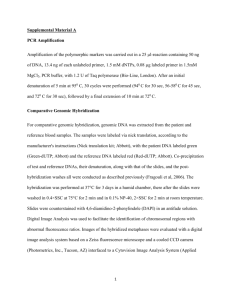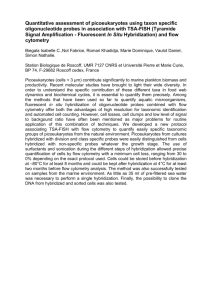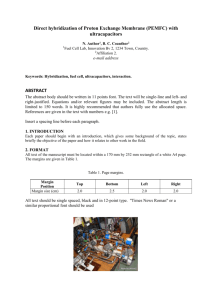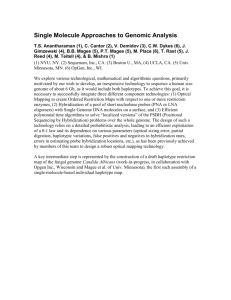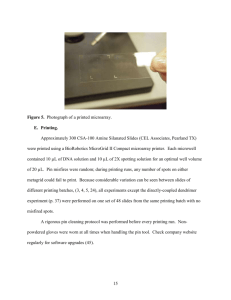Supplementary Information (doc 30K)
advertisement
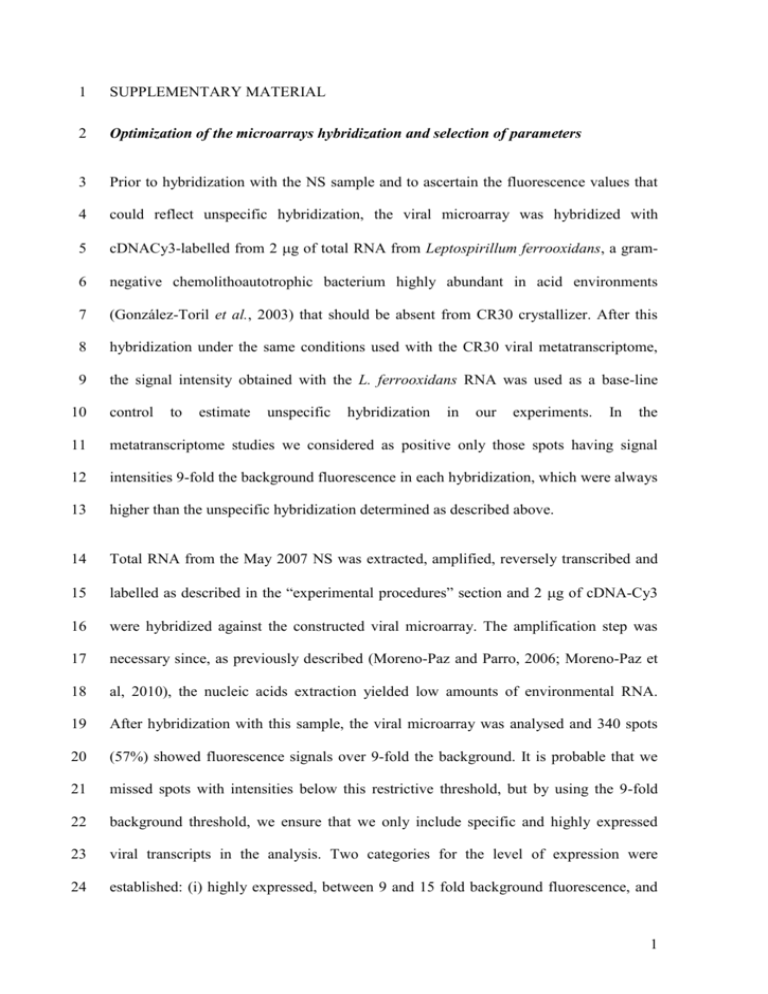
1 SUPPLEMENTARY MATERIAL 2 Optimization of the microarrays hybridization and selection of parameters 3 Prior to hybridization with the NS sample and to ascertain the fluorescence values that 4 could reflect unspecific hybridization, the viral microarray was hybridized with 5 cDNACy3-labelled from 2 g of total RNA from Leptospirillum ferrooxidans, a gram- 6 negative chemolithoautotrophic bacterium highly abundant in acid environments 7 (González-Toril et al., 2003) that should be absent from CR30 crystallizer. After this 8 hybridization under the same conditions used with the CR30 viral metatranscriptome, 9 the signal intensity obtained with the L. ferrooxidans RNA was used as a base-line 10 control to estimate unspecific hybridization in our experiments. In the 11 metatranscriptome studies we considered as positive only those spots having signal 12 intensities 9-fold the background fluorescence in each hybridization, which were always 13 higher than the unspecific hybridization determined as described above. 14 Total RNA from the May 2007 NS was extracted, amplified, reversely transcribed and 15 labelled as described in the “experimental procedures” section and 2 g of cDNA-Cy3 16 were hybridized against the constructed viral microarray. The amplification step was 17 necessary since, as previously described (Moreno-Paz and Parro, 2006; Moreno-Paz et 18 al, 2010), the nucleic acids extraction yielded low amounts of environmental RNA. 19 After hybridization with this sample, the viral microarray was analysed and 340 spots 20 (57%) showed fluorescence signals over 9-fold the background. It is probable that we 21 missed spots with intensities below this restrictive threshold, but by using the 9-fold 22 background threshold, we ensure that we only include specific and highly expressed 23 viral transcripts in the analysis. Two categories for the level of expression were 24 established: (i) highly expressed, between 9 and 15 fold background fluorescence, and 1 1 (ii) very highly expressed, above 15 fold the background fluorescence. Prior to double 2 hybridizations between C and stressed samples (UV and D), the NS was hybridized 3 against C1 to see if maintaining the sample in the laboratory might cause an over- 4 expression of viral genes in the sample. After the analysis, we could not detect over- 5 expression in any spot (data not shown), which indicated that the over-expression 6 observed in the stressed samples was due to applied treatments. For all the double 7 hybridizations, data were filtered and normalized and spots that showed a total intensity 8 (the sum of both Cy5 and Cy3 channels) equal to or higher than 9 fold background 9 fluorescence (see above) were selected. The ratios between control samples versus 10 stressed samples were compared and the spots that showed a fluorescence at least two 11 times higher in the treated samples, were selected for the final analysis. 12 FISH analysis in the May 2009 sample 13 The NS taken in May 2009 had 34% salinity. Archaea and Bacteria accounted for 14 79.35% and 10.31% of the DAPI counts, respectively. UV, D and C subsamples were 15 analysed as described in the “experimental procedures” section of the manuscript. 16 Data showed that Bacteria were very sensitive to UV treatment, with reductions of up to 17 30% while Archaea suffered more dramatically the change in the salinity (with losses of 18 up to 23%, compared to losses in Bacteria, that accounted for 10%). Results are shown 19 in supplementary Figure 1 and are in agreement with data obtained in the stress 20 experiments carried out in 2007: members of Bacteria recovered after the radiation 21 treatment, while Archaea showed a higher decrease with reductions of up to 50% and 22 33% under dilution and radiation conditions, respectively. 23 2 1 Legends 2 Fig Sup 1. Changes in the number of total cells (DAPI), Archaea and Bacteria with 3 time after the application of the stress treatmens, compared to values in the natural 4 sample (NS) taken in May 2009. Green lines are the values of the control samples. In 5 red (UV), the number of cells after the UV-radiation treatment. In blue (D), the number 6 of cells under osmotic shock. Black lines (DT) represent the theoretical values after the 7 dilution of the sample without considering lysis. 8 9 3

